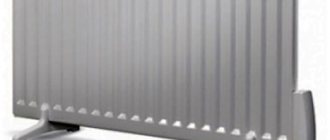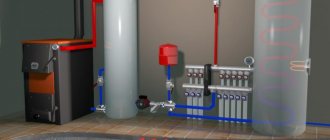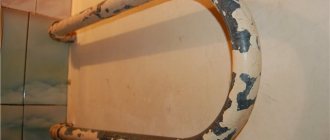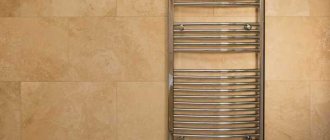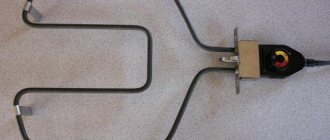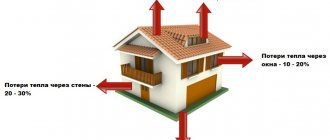A heated towel rail is a multifunctional bathroom accessory. It serves not only for drying towels, but also serves as a heater. A stylish model of modern design decorates the room and divides it into zones.
The devices differ in design, technical characteristics, and installation method. Let's look in detail at how to choose an electric heated towel rail for the bathroom and what parameters you should pay attention to.
The article is supplemented with information about the best manufacturers, whose products are in demand and have won positive customer reviews.
A heated towel rail is an indispensable bathroom appliance.
An electric heated towel rail is a simple design made of a curved pipe and a heating element connected to a power source. Connection features depend on the design of the model. The device itself is attached to the wall or installed on the floor.
Most often, devices are purchased for bathrooms, but sometimes they are also appropriate in kitchens. The devices perform the functions of a towel dryer and warm up the air. Bathrooms are usually small, so such a modest radiator is enough to create a comfortable temperature.
The shiny surfaces of the heated towel rail harmonize with chrome and nickel-plated sanitary fixtures, and also visually expand the space: the bathroom seems larger and brighter
Regular heating of the bathroom prevents condensation and dampness. Thanks to this, the fungus multiplies less, which can completely ruin the finishing materials in a short time and even cause respiratory diseases among the residents of the house. Preventing the formation of black mold is easier than fighting it later.
A good heated towel rail is essential for any bathroom, especially in a home with small children. The main thing is to take into account all the features of the room and choose a device of suitable design and power.
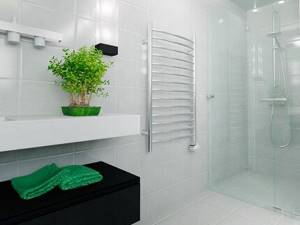
For spacious bathrooms, it is better to choose powerful models equipped with additional measuring and control devices - timers and thermostats.
Technical device options, heat saving
Energy consumption directly depends on the design of the selected device. Depending on the type of internal device, electric towel rails are divided into two groups:
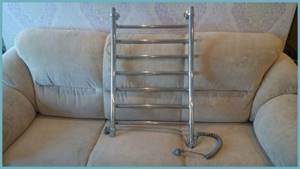
Both types of dryers can heat up to 80 degrees. Celsius and have installed internal overheating protection. The difference is that oil-based ones take much longer to warm up, which is due to the peculiarities of their internal structure, but after switching off the devices continue to give off heat for a long time.
Their hollow structure is filled with liquid, which is heated by a heating element - it is this that consumes a significant amount of energy during the primary heating process. Within 15 minutes and a maximum of 1 hour, the heating element heats the filler, as well as the heater body itself, which consumes no more than 600 W.
All subsequent expenditures of electricity, as soon as the device is fully heated, are spent on maintaining the achieved temperature level, that is, the operation of an electric heated towel rail no longer requires such a large consumption of electricity.
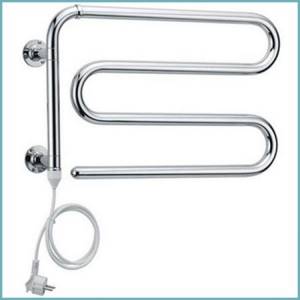
Models that have a so-called heating cable in their design almost instantly reach the maximum temperature regime set by the manufacturer and, accordingly, cool down just as quickly (no more than 20 minutes). They are characterized by significantly lower energy consumption compared to heating elements, but the heat transfer from cable devices will also be lower.
Average consumption figures usually vary between 35–165 W throughout the entire operating period, regardless of the switching stage. Typically, their design does not provide for the installation of a thermostat, since they are low-productive and can be used exclusively for drying clothes, and not for heating the bathroom area.
Attention! It is not recommended to dry items made of silk or wool using cable-type devices, since due to the lack of a regulator it is impossible to lower the temperature to the optimal temperature for delicate fabrics.
Advantages of electric coils
The list of arguments in favor of purchasing an electrical appliance includes:
- Economical. The devices consume a minimum of electricity, but their power is enough to warm up the bathroom. The disadvantages include the fact that heated towel rails still consume electricity.
- No leaks. Water models are subject to corrosion and sooner or later begin to leak. Nothing like this can happen with dry-type electrical devices.
- Wide design potential. Electric models are very diverse. There are stylish designer models that can become the main decoration of the bathroom.
- Independence from pressure in communication systems. The efficiency of water heated towel rails largely depends on the pressure in the water supply system; sometimes they perform their functions worse due to air pockets. Electric models do not have these disadvantages.
- Minimum emergency shutdown time. Power outages are a common occurrence in many areas, and this is a negative. However, there is a plus: if they happen, it is for a short time. Interruptions in hot water occur less frequently, but can last for weeks until repair or maintenance measures are completed.
Another significant advantage is the ability to easily change location. Moving a water device to another place is a labor-intensive task, because... the device is connected to the hot water supply or heating system.
To move an electric heated towel rail, simply rearrange the fastenings. It takes just minutes.
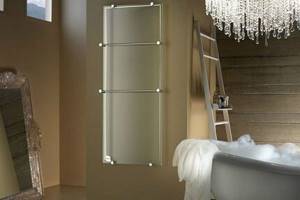
Designer models of electric heated towel rails create an atmosphere of warmth and special comfort, thanks to which you can completely relax and unwind in the bathroom
Electric heated towel rails are demanding in terms of installation location and power supply. Many breakdowns are associated precisely with non-compliance with the rules of connection and operation. You will be able to identify and fix a number of problems yourself.
How to insulate a bathroom
When making a decision about insulating an apartment, the bathroom is rarely thought of. And in vain! If there is no insulation, then many complain about dampness and low temperature in the room. Therefore, there is no desire to go into such a “damp” room, and I don’t really want to do anything there. This situation is observed in high-rise buildings after the heating season comes to an end. But you can’t do without a bathroom, so you need to know how to insulate the floor in the bathroom, as well as the ceiling and walls. It is better and more economical to insulate this room inside. External insulation is carried out only in the summer and with the help of expensive materials with payment for the services of specialists.
Floor insulation
1. Installation of heated floors. This is the most reliable and effective method to rid the bathroom of cold and dampness. A warm floor will warm up a room perfectly; you can install it yourself, or you can entrust this task to specialists. This type of insulation has many advantages and you can independently regulate its temperature.
2. Insulation with conventional insulation. Suitable materials to solve this issue would be mineral wool, fiberglass, polystyrene foam and basalt fiber. These materials are distinguished by excellent thermal conductivity, durability and water resistance.
3. Independent insulation. Remove everything you can from the bathroom and get rid of the old coating. Then level the concrete base. Lay the slabs of the selected insulation, on top of which you need to lay a layer of vapor and sound insulation materials. Next, make a screed made of reinforced mesh. Don’t forget to foam the perimeter so that the screed does not come into contact with the walls. Now all you have to do is wait until the screed has dried well and place tiles or linoleum on the new base.
Wall insulation
1. Foam plastic. You can insulate the wall in the bathroom with polystyrene foam. He is not afraid of moisture. Mineral wool is less suitable as insulation, since moisture absorption worsens its properties. There are also more expensive materials - penofol and extruded foam. When working, you need to take into account that insulating the walls will cause them to become thicker and therefore reduce the usable area of the room. Don't forget to think about good ventilation.
2. The first method of insulation. The wall is cleaned and coated with anti-fungal agent. Then penofol or extruded foam is glued to the wall. Moisture-resistant drywall is glued on top of this glued material. Ceramic tiles are already placed on the drywall.
3. The second method of insulation. A metal frame is made; a wall profile for gypsum plasterboard can be used for it. Then you need to lay the selected insulation in two layers. Isopan is stretched over this structure. Two layers of plasterboard, which is resistant to moisture, are glued on top, and then you can begin finishing the wall.
Ceiling insulation
1. The best option is to install a suspended ceiling made of plasterboard. It is also advisable to insulate the ceiling in the bathroom. The space between the drywall and the ceiling is insulated using polystyrene foam. An easier insulation option is foam plastic decorative elements, such as foam tiles or wallpaper.
Useful tips
Particular attention is paid to installing a reflective screen. It is placed behind a heated towel rail or behind a radiator. Such a screen reflects heat and correctly distributes it throughout the room and retains it.
The screen consists of aluminum foil
Such a screen reflects heat and correctly distributes it throughout the room and retains it. The screen consists of aluminum foil.
Types of electric heated towel rails
There are “wet” and “dry” designs. In models of the first type, heating is carried out by a coolant (water, antifreeze or oil), which is heated by a heating element. According to the principle of operation, they are similar to electric heaters.
Differences in operating principle
Each type of coolant has its own advantages and disadvantages. Oil retains heat the longest after the power is turned off, but the maximum possible temperature of an oil heated towel rail is 70°C. The water warms up to 85°C, but cools down faster. Antifreeze has high thermal conductivity.
The advantages of “wet” appliances include the ability to retain heat after being disconnected from the network. The downside is that it consumes more electricity than “dry” heated towel rails. Another disadvantage is the shorter service life of heating elements, since they wear out faster in liquid.
Models with a “dry” heating element are more durable than their “wet” counterparts. On average, they last 3-5 years longer, although this largely depends on the quality of materials and assembly of the devices.
Devices of this type consume a minimum of electricity, and the range of models is more diverse, which expands the design possibilities of premises owners.
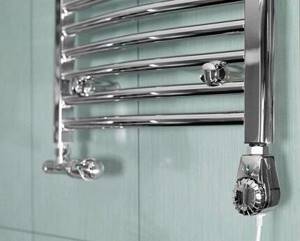
The type of coolant used in combined heated towel rails practically does not matter, because... Heating and cooling times are rarely critical
Execution form of different models
There are heated towel rails of various configurations, and designer models sometimes simply amaze with their elaborate design. But despite all the diversity, there are two traditional forms - snake and ladder.
Owners of devices have long been convinced that, despite their simplicity, both types of devices are practical. Which form should you prefer? Experts advise choosing a ladder.
There are several reasons for this:
- It is more convenient to place things to dry on the rungs of the heated towel rail-ladder: they do not slide off.
- Long items dry out faster because... heating is carried out along their entire length.
- The heating area of such a device is larger, which means the room will warm up better.
Snake-shaped heated towel rails have their advantages. They are cheaper because... Fewer materials are required to make them. In addition, such models are more compact and require less space for installation, which is important when there is a shortage of free space.
In many cases, it makes sense to buy a heated towel rail with sliding elements. When folded, it resembles a ladder, but the side parts can be moved to the sides and several things can be hung on them. Models with shelves are also convenient.
The final decision should be made after comparing prices, models and choosing a location for installation.
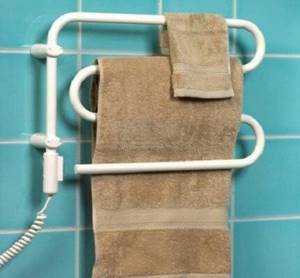
Snake-shaped models are beautiful, but towels can slide off smooth rounded surfaces, so they should be hung by hanging them by the pipes of the device
Wall and floor heated towel rails
Typically, wall-mounted heated towel rails are installed in bathrooms, and for tight spaces this is the only correct solution, because... allows you to save space. But if the space allows, you can choose a floor-standing model, which has its own important advantages.
Floor-standing electric models appeared on the market relatively recently, but have already attracted the interest of many buyers. They are designs that combine the advantages of both heated towel rails and heaters. The devices are reliably protected from dampness and effectively heat the premises.
To install floor-standing models, you do not need to drill into the walls to mount the fasteners: you just need to place them in a convenient place and plug them into a power outlet. The devices are equipped with stable legs, so they do not tip over. If necessary, the heated towel rail can be easily moved to another location.
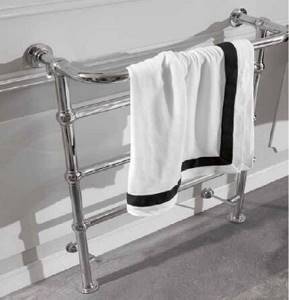
For more reliable fixation, floor heated towel rails can be additionally attached to the walls; for this purpose, the manufacturer provides special brackets
Which material should you prefer?
For the manufacture of electric heated towel rails, ferrous, stainless steel and non-ferrous metals are used. The cheapest models are made of black steel.
On the outside, the devices are almost no different from stainless steel products, and the internal surfaces of the tubes are coated with an anti-corrosion compound. Despite the treatment, black steel deteriorates quite quickly, and this is a big disadvantage.
Stainless steel models are universal and suitable for almost any bathroom. Painted heated towel rails are cheaper than chrome ones, but they also lose their presentable appearance faster. When purchasing a stainless steel device, you should take into account the “capriciousness” of their threaded connections. It is better to have such a heated towel rail installed by a specialist.
Designer models are often made of aluminum, copper or brass. Brass heated towel rails are extremely beautiful, have good heat transfer properties, but are rarely durable.
Copper models are almost flawless, but they are several times more expensive than devices made from other materials.
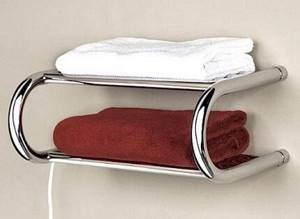
Chrome heated towel rails are more expensive than devices with a polymer colored coating. They last longer because the protective and decorative shell of painted models is easier to damage, creating conditions for the appearance of a rust spot.
Which heated floor to choose?
The preferred heated floor in the bathroom is water. It is relatively simple to install and low in energy costs. This is a reliable design that, if connected correctly, will work for years without experiencing any problems or difficulties.
A bathroom floor made to your taste is ideal for use and will meet the strict requirements that are placed on it. What specific type of TP is up to the owners to decide, focusing on the knowledge gained and the initial conditions.
The effect of a heated floor in the bathroom is worth the effort and finances at the installation stage. Having once lived in an apartment with heated floors, a person will no longer be able to refuse them in favor of regular ones - you get so used to the constant warmth in the bathroom. Modern materials contribute to the popularity of TP; they are suitable as a finishing coating and are not afraid of heat. A warm floor is superior in terms of heat output characteristics to a conventional heated towel rail.
Warm floor: an indispensable thing in every home!
Guidelines for wise choice
The list of characteristics that you should focus on when choosing a heated towel rail includes:
- Design and installation method . Typically, bathrooms are not large in size, and a large number of plumbing fixtures and furniture have to be placed in them, so design is an important selection criterion. Even before purchasing a device, you should think about where it will be installed and how it will fit into the interior of the room.
- Power. It is necessary to calculate this figure so that for each square meter of the bathroom there is 150-200 W of power. When installing less powerful models, the room will be damp, and a device that is too powerful is more expensive and wastes energy.
- Method of connecting the device to the network. Heated towel rails are connected in open and hidden ways. When the connection is open, the wires from the appliance to the electrical outlet run along the surface of the wall. When hidden, they are disguised under the finishing. The first connection method is much simpler, and the second is safer.
- Economical. The power consumption of different types of appliances can vary significantly. Heating elements with a power of 100-2000 W are installed in heated towel rails. Powerful devices are often equipped with sensors and automation that turns them off when the set temperature is reached. This allows you to use energy resources more economically.
- Heating element type. Typically, the power of devices with “dry” and “wet” heating elements is the same, and the difference is only in the speed of heating and cooling. Most often, these are not fundamental indicators, but they are worth taking into account.
- Additional functions. Some models have timers, thermostats and other useful features.
We recommend paying attention to models with additional functions. Usually their cost is higher than that of “simple” heated towel rails, but such expenses pay off.
For example, people who shower before starting work often set a timer half an hour before waking up so that the bathroom is warmed up to a comfortable temperature in advance.
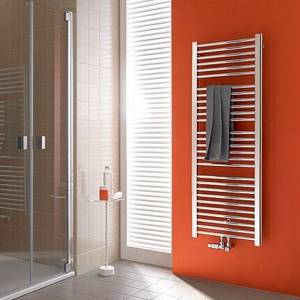
Timers and thermostats are not useless elements that manufacturers add to increase the cost of products, but truly convenient devices
A thermostat in a heated towel rail can be very useful for families with small children. The device maintains a constant temperature, so you can wash or bathe your baby at any time in a warm bathroom and dry it with a dry towel, while energy consumption is extremely efficient.
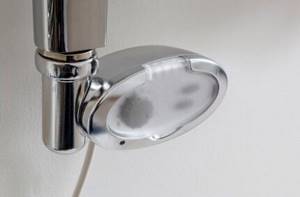
Thermostats not only maintain the set temperature, but also perform a protective function: they prevent overheating of the device, which is especially important for models with a heating cable
Economical materials for floor insulation
Of course, one cannot fail to mention materials such as expanded clay, ecowool and sawdust insulation. They are often used, and all thanks to their availability and low price. However, these insulation materials have many disadvantages.
Expanded clay has a high thermal conductivity index, relative to the materials presented above, which means it is necessary to increase the thickness of the thermal insulation layer
This is especially important when carrying out floor leveling work.

At the same time, we are not talking about the lightest material, which means that the supporting structure will have to be strengthened. When we talk about floor construction, this is not always acceptable.
Ecowool is a good floor insulation material in terms of thermal insulation characteristics, however, it is very susceptible to moisture. So, laying such insulation will require the creation of an additional waterproofing layer, and ecowool can only be used in those rooms where the relative air humidity does not exceed normal limits.
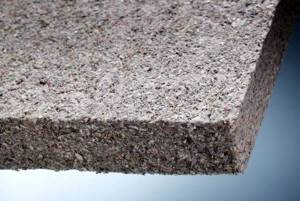
As for sawdust insulation, this is, as they say, a thing of the past. Yes, sawdust is easy to use and can be used to fill almost any air void under the floor. But sawdust ignites very quickly and burns well, and also requires special treatment with antiseptics and fire retardants. That is why the insulation materials listed in this section are used less and less.
The best Russian and foreign manufacturers
The heated towel rail market is diverse: you can find models of any quality, design, price, so you should pay special attention to the brand and reputation of the manufacturer. Let's consider which electric heated towel rails our compatriots consider the best.
The Italian company Margaroli produces models with power from 100 to 300 W. All of them are distinguished by a thoughtful design and increased comfort in operation.
Best manufacturers:
- Kermi. Kermi heated towel rails are truly German quality and Swiss reliability. The Kermi brand has been known on the market for more than half a century and is already considered legendary. The main advantage of this brand’s equipment is its reasonable price-quality ratio. Heated towel rails are made of good steel, mainly in the shape of a ladder. They are durable, reliable, and stylistically neutral.
- Arbonia. Designer radiators and heated towel rails from the Swiss company Arbonia are an expensive pleasure, but the quality and appearance of the products are beyond praise. Models are made of steel. Antifreeze is used as a coolant for combined heated towel rails. It is possible to manually adjust the heating temperature.
- Margaroli . Italian appliances from the Margaroli brand are not affordable for everyone. Heated towel rails of this brand are made of high-quality expensive materials and equipped with automatic equipment. There are devices made of brass. Distinctive features of Margaroli equipment are exquisite design and durability. The manufacturer is so confident in the quality of the product that it provides a 15-year guarantee.
- Energy . Energy Group is one of the leaders in the European heating equipment market. The manufacturer produces durable, high-quality devices. Any design: the range includes flat, three-dimensional, rotary models of various configurations. The Energy U G3K heated towel rail is especially popular because... combines good technical characteristics and reasonable price.
- "Sunerja". The Russian company produces elite models of heated towel rails, which are in demand not only in the domestic but also in the European market. The models are varied in design, made of stainless steel with a durable shiny coating. The warranty for Sunerge products is 5 years.
- "Dvin". The Russian company has produced more than 30 series of heated towel rails made of polished stainless steel. Most of the models are made in the form of a ladder. The manufacturer provides a 1 year warranty on its products.
- "Nika". Electric heated towel rails of the Nika brand have been known on the market for more than 10 years. Buyers value branded products for their good quality and stylish design. The company does not produce rotating models, but there are many interesting heated towel rails with shelves. The warranty on this company's products is 5 years.
- Terminus. The main advantage of heated towel rails of the Russian brand Terminus is a wide selection of models. Among them there are both budget and expensive ones. The heated towel rails are made of 2 mm thick steel. The models are distinguished by high performance characteristics and stylish design. The manufacturer provides a 10-year warranty.
- "Leader-Steel". Many buyers prefer products. The heated towel rails are made of stainless steel, the heating temperature can be adjusted from 30 to 70 degrees. In case of overheating or hypothermia, the devices turn off automatically. The manufacturer provides a 5-year warranty.
- Terma . The Polish company Terma has been known on the market for more than a quarter of a century. During this time, it gained popularity among our compatriots.
Terma heated towel rails are made of high quality steel and equipped with thermostats.
A number of manufacturers produce, in addition to electric, water and combined models.
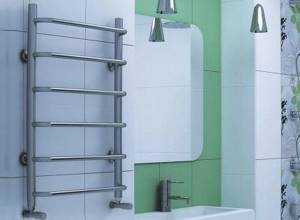
Terminus brand models are made in Russia: the manufacturer uses high-quality imported materials, in particular Italian stainless steel
Most popular models
The range of units equipped with a programmable thermostat is constantly expanding every year due to growing demand from consumers. Among the most popular today are products from the companies NIKA, Energy, PAX, Zehnder and Hitze, Margaroli and Devon & Devon of various sizes and modifications, among which you can easily choose the appropriate option to suit your taste and budget.
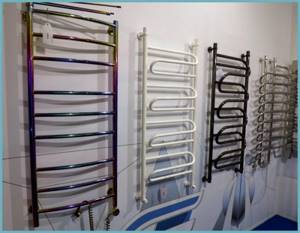
Classic ladder-shaped models are the most budget-friendly and most common. In addition to them, you can choose an S- or E-shaped device that will suit the design of a specific bathroom. The line also includes non-standard and designer solutions, which will cost a little more, but will become a real decoration of the interior.
For several decades now, E-shaped dryers with a rotary mode have been considered one of the most convenient and functional, allowing you to dry not only towels, but also custom-tailored items, as well as shoes.
